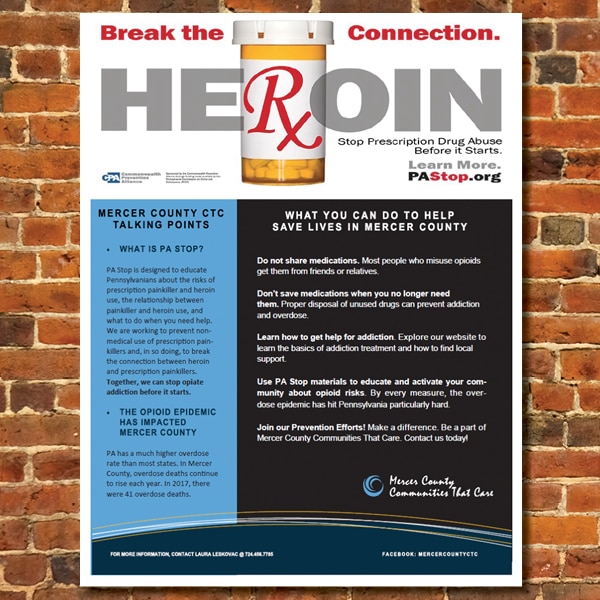We love the way the Mercer County CTC disseminated PA Stop materials through their existing evidence-based prevention programs, like Strengthening Families and Strong African American Families. We also think their talking points poster is a great innovation. In this interview, Laura Leskovac describes some of their exciting work.
1. Tell us about your organization. What do you do? Who do you serve?
Mercer County Communities That Care (CTC) is a community-based collaborative coalition that exists to prevent juvenile delinquency by promoting and encouraging positive, healthy behaviors. Mercer County CTC operates and supports evidence-based programs and practices such as the Strengthening Families Program 10-14, Strong African American Families (SAAF) Program, and Motivational Interviewing. We also recently began the implementation of student-driven Aevidum clubs in local school districts, which is a suicide prevention program.
2. How long have you been using PA Stop in your work?
The Mercer County CTC was introduced to PA Stop materials at the Commonwealth Prevention Alliance conference several years ago, but we did not start using it at the CTC until we received a mini-grant in the fall of 2018.
3. Tell us about some of the ways that you have utilized PA Stop to spread information about opioids.
We used an environmental strategy to disseminate as much information as possible. We targeted parents of high school students to raise awareness about the dangers of prescription drug misuse, with an underlying goal of reducing prescription drug misuse among teens.
Our dissemination strategies include a social media campaign using our Mercer County CTC and the Mercer County Aevidum Facebook pages. We also use our high school Aevidum clubs to help disseminate information to parents, especially during awareness nights at basketball games.
We made sure to provide the family toolkit booklet to all participants in our evidence-based prevention programs, such as the Strengthening Families Program and Strong African American Families Program. There is also a crisis intervention team among police officers and they were given materials for when they come in contact with people who are struggling with mental health or addiction.
In addition, one of our county commissioners (Scott Boyd) contacted the county Chamber of Commerce associations and they added the link to PAStop.org on their webpages for free access to the Workplace Toolkit so employers can help educate their workers on how to address the dangers of opioid misuse.
This past Thanksgiving, we were out from 6-11am in 20 degree weather at the 5K Gobble Wobble passing out PA Stop bracelets and information to runners. One of our county commissioners (Tim McGonigle) connected us to the Shenango Valley River Watchers who allowed us to participate in this event. In addition to the Gobble Wobble, for Christmas, one of our youth groups marched in the Christmas light up parade. We used the PA STOP “Don’t add to the numbers” vinyl banner, and added lights to it so it flashed and lit up!
Youth and adult advisers passed out bracelets along the parade route. We live in a very small town that’s been hit pretty badly by the opioid epidemic, and almost everyone in the town was there and saw it.
4. What do you think are the most exciting or successful ways that PA Stop has helped you achieve your mission? We are particularly interested in tangible success–do you have any data or have you received any feedback that shows success?
We do not have any quantifiable results yet, but in regards to short term success, we’ve seen an increase in participation in the CTC prevention board, especially from the faith-based community. This was definitely unexpected, but faith leaders are looking for guidance on how to prevent drug misuse in their communities. Our CTC joined Kingdom Unification in their efforts by attending their prayer meetings and handing out materials.
5. Are you currently make any new plans that involve PA Stop resources?
We have no current plans, but we’re in the process of securing funding to use more materials. Our funding source is a local community organization, and they don’t take applications until fall. But we’re still using left-over tool kits from our initial order!
6. We are trying to help organizations and SCAs understand how they can use PA Stop in their communities. Do you have any advice or words of wisdom, based on your experience?
Mercer County CTC created a “talking points flyer” that outlined what PA Stop is and how anyone can use the campaign. We really think that other organizations should have something similar.
Most people are handed a stack of papers with information and their first thought is (reasonably), “What should I do with this?” The talking points flyer offers some information like, “Here is the number of overdoses that occurred last year, and this is one way that we are working to decrease those numbers.”
There are many people that want to help, but aren’t necessarily well-versed in drug education/prevention, so having the talking points one-pager is really nice.
Another piece of advice is to identify your target audience so that the tools can be used successfully. For example, originally we thought that our target audience would be teenagers. However, after looking at our data and considering our outreach resources, realized that we actually needed to target the parents of teens. It’s so important to find data pertinent to your community–your initial population of concern and your eventual target population might not be the same.



